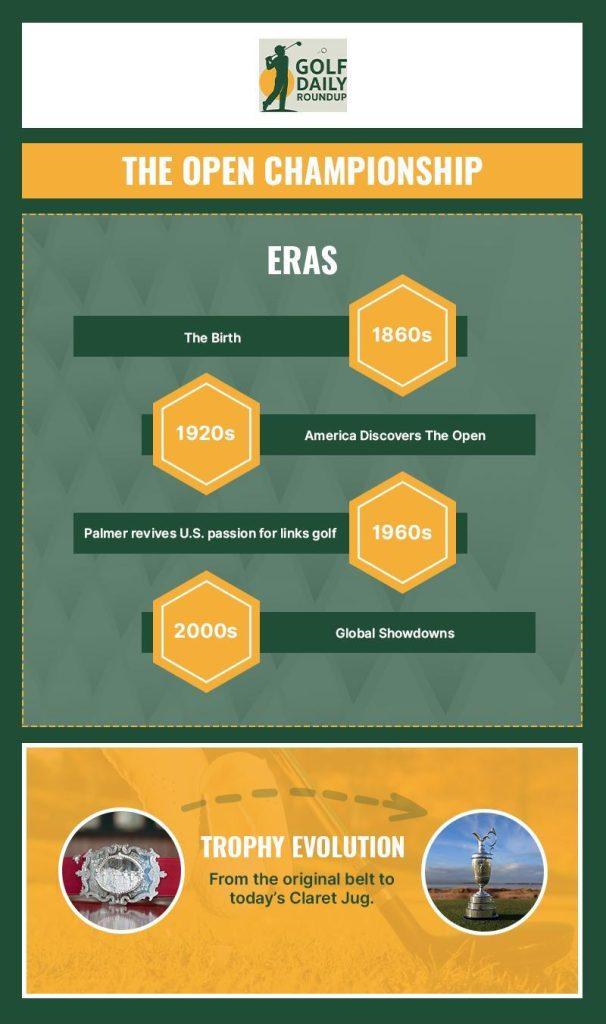The Open Championship: History, Origins, and Venues of Golf’s Oldest Major

Introduction
The Open Championship, often called The Open, is golf’s oldest and most prestigious major. Every year, the best players compete on historic links courses across the UK. They face wind, weather, and pressure — all in pursuit of the Claret Jug. This article explores The Open Championship history, from its origins to its most iconic venues and champions.
Origins of The Open Championship (1860)
The origins of The Open Championship trace back to Prestwick Golf Club in Scotland. The first event took place on October 17, 1860, now known as the Open Championship founding year. After the death of Allan Robertson, who was then the top golfer in the world, the golf community needed a new “Champion Golfer.”
Eight professional players entered the first competition. They played three rounds of 12 holes — all in one day. Willie Park Sr. emerged as the first Open Championship winner, beating Old Tom Morris by two strokes.
There was no trophy or cash prize. Instead, Park received a red leather Challenge Belt, decorated with silver clasps — a symbol of honor at the time. This marked the beginning of the Prestwick Open Championship legacy.
Later, Old Tom Morris made his mark. He won The Open four times: 1861, 1862, 1864, and 1867. A true pioneer of the game.
His son, Young Tom Morris, became a golf prodigy. A legend in his own right, Young Tom Morris Open Champion made history by winning four consecutive Open Championships from 1868 to 1872 — a feat still unmatched.
The Claret Jug History and Legacy
In 1870, Young Tom earned permanent ownership of the Challenge Belt after his third straight win. With no prize ready, The Open wasn’t held in 1871. By 1872, the organizers agreed to create a new trophy — the Claret Jug.
Though the jug wasn’t ready in time, Young Tom won again. In 1873, the Claret Jug history officially began when the trophy was presented to champion Tom Kidd. Its full name is The Golf Champion Trophy.
Today, the original jug stays at the R&A Clubhouse in St Andrews. Winners take home a replica — a reward as legendary as the tournament itself.
The Open Becomes Truly “Open”
In 1861, The Open allowed amateur golfers to enter. That decision made the event open to all — not just professionals. It was a game-changing moment in the evolution of The Open Championship golf.
Soon, the field grew. Golfers from outside Scotland began competing. By the early 20th century, the championship had a global feel.
Players like Harry Vardon, James Braid, and Bobby Jones elevated the event’s status. Later, American stars like Walter Hagen made the journey across the Atlantic to compete — and win.
In the 1960s, Arnold Palmer helped revive U.S. interest. His wins in 1961 and 1962 brought global attention back to The Open.
Iconic Moments and Legendary Champions

The Open Championship history is filled with dramatic finishes, emotional victories, and defining duels:
- In 1977, Tom Watson defeated Jack Nicklaus in the famous “Duel in the Sun” at Turnberry.
- Tom Watson won the event five times — a record few have matched. In 2009, at age 59, he came within a single putt of winning again. But a missed par at the 72nd hole led to a playoff loss to Stewart Cink.
- Jack Nicklaus, a three-time Open champion (1966, 1970, 1978), showed deep respect for links golf. His 1970 win at St Andrews remains one of his most emotional victories and a defining part of Royal and Ancient Club Open history.
- In 1999, Jean van de Velde needed only a double bogey on the last hole to win at Carnoustie. Instead, he triple-bogeyed and lost in a playoff — a moment burned into golf memory.
- In 2006, Tiger Woods won at Royal Liverpool, just weeks after his father’s passing. His emotional, strategy-focused win moved fans worldwide.
- Phil Mickelson staged a stunning comeback at Muirfield in 2013, shooting 66 in the final round to claim his first Open.
- In 2016, Henrik Stenson and Mickelson delivered a showdown for the ages at Royal Troon. Stenson’s final-round 63 earned him a -20 total and a three-shot win — both separated by 11 strokes from the rest of the field.
- In 2014, Rory McIlroy led wire-to-wire at Royal Liverpool, winning his third major by age 25.
- Shane Lowry’s powerful win at Royal Portrush in 2019 brought The Open back to Northern Ireland — and joy to a home crowd.
Other greats — Seve Ballesteros, Nick Faldo, Ernie Els, and Collin Morikawa — have also lifted the Claret Jug, securing their names in history.

The Open Championship Venues: Where History Happens
One thing that sets The Open apart is its rotating venues, known as the Open Rota. These are legendary links courses, built near the sea, shaped by dunes and wind.
How Are Venues Selected?
The R&A selects courses based on:
- Authentic links design
- Historical significance
- Infrastructure for fans and broadcasters
- Geographical balance (Scotland, England, Northern Ireland)
Some venues host more often, like St Andrews and Royal Birkdale. Others — like Turnberry — appear less frequently but remain iconic.
The Current Open Rota
| Course | Location | First Hosted |
|---|---|---|
| St Andrews (Old Course) | Scotland | 1873 |
| Royal Troon | Scotland | 1923 |
| Carnoustie | Scotland | 1931 |
| Muirfield | Scotland | 1892 |
| Turnberry (Ailsa) | Scotland | 1977 |
| Royal Liverpool | England | 1897 |
| Royal St George’s | England | 1894 |
| Royal Lytham & St Annes | England | 1926 |
| Royal Birkdale | England | 1954 |
| Royal Portrush | Northern Ireland | 1951 |
Prestwick, where it all began, last held The Open in 1925. Its small size limits modern use, but it remains central to The Open Championship history and the Prestwick Open Championship legacy.

Last 10 Open Championship Venues, Winners & Scores
| Year | Venue | Winner | Score |
|---|---|---|---|
| 2024 | Royal Troon, Scotland | Xander Schauffele | -8 (276) |
| 2023 | Royal Liverpool (Hoylake) | Brian Harman | -13 (271) |
| 2022 | St Andrews (Old Course) | Cameron Smith | -20 (268) |
| 2021 | Royal St George’s, England | Collin Morikawa | -15 (265) |
| 2020 | Cancelled (COVID-19) | — | — |
| 2019 | Royal Portrush, N. Ireland | Shane Lowry | -15 (269) |
| 2018 | Carnoustie, Scotland | Francesco Molinari | -8 (276) |
| 2017 | Royal Birkdale, England | Jordan Spieth | -12 (268) |
| 2016 | Royal Troon, Scotland | Henrik Stenson | -20 (264) |
| 2015 | St Andrews (Old Course) | Zach Johnson | -15 (273, playoff) |
Conclusion
From the first Open Championship winner in 1860 to record-setting duels in recent years, The Open stands as a symbol of golf’s enduring greatness. Its rich traditions, the legendary Claret Jug history, and the drama of links golf make it unlike any other major.
Whether you’re drawn by the wind-swept courses, the fierce rivalries, or the tournament’s deep roots in Royal and Ancient Club Open history, The Open Championship is where golf’s past and future meet — every July, every shot, every champion.






